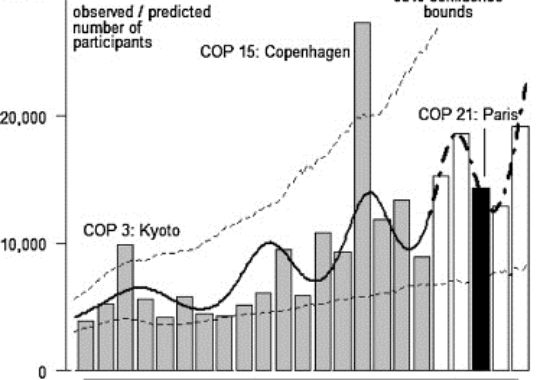In the conclusion of The Durban Platform: Issues and Options for a 2015 Agreement, Daniel Bodansky states, “The challenge now is to retain sufficient flexibility to achieve strong participation while also raising ambition—both in terms of legal form and, more importantly, in the collective level of effort” (Bodansky 11) in regards to achieving the best possible post 2020 agreements. Bodansky believes the effectiveness of the outcome will be dependent on stringency, participation, and compliance, (Bodansky) however, this view leaves out other essential themes; accountability, ambition, transparency, and flexibility. The greatest outcome possible will require all of the above. This could be achieved by a “mixed track” approach, meeting exactly in the middle of “top-down” and “bottom-up” approaches.
Daniel Bodansky lists different options for a Durban Platform outcome, each with aspects that may work and others that raise questions. (Bodansky) The outcome of the Durban Platform needs to dive in to a transparent-stringent-internationally-legally-binding approach that must become the norm through raising national accountability and action transparency.
Legally-binding agreements must be set, focusing heavily on the common but differentiated responsibilities and respective capabilities (CBDRRC) of different countries; specific emissions reductions strategies and plans need to be set for each country/region. (Bodansky) Although the bottom-up approach may seem “the easiest to achieve politically” (Bodansky 8), it lacks ambition because individual bodies are setting their own actions based on preferences. In order to promote more ambitious action plans, others need to be involved in helping set agreements. If there were a way to physically take every country, in dialogue with each other, and have them set agreements for each one but converse collectively on them, this would be the most ideal situation.
This would require keying in on the CBDRRC aspects in order to promote the most equitable yet stringent plans. (Bodansky) “Countries will be more willing to negotiate commitments if the terms of engagement ensure that both they and their counterparts are negotiating within tracts appropriate to their respective circumstances” (Bodansky 10). The fact that dialogue would be cohesively international, would ensure this and furthermore, would hopefully, raise accountability and increase compliance.
Additionally, mandatory language such as “shall” rather than hortatory language, “should”, needs to be precedent. Plans need to be joint and certain from the beginning, but also allow room for alteration and change in the future, again through open dialogue. (Bodansky)
Picture the practice of any team sport, the coach asks, “Do we want to run today?”. The accountable athlete, who always wants to better themselves, will say yes and the complacent athlete who does not often push themselves, will say no… In the end, it’s a trick question anyway, and the coach expects everyone to say yes. When you have a cohesive accountable team working towards specific goals, everyone knows to say “yes” because it’s what they have to do to achieve their goals. The unified and liable team, it the team that make it to the play offs.
This is what must happen in climate governance. Communication needs to be open, cooperative, and decisive. Somewhere between the bottom-up and top-down approaches, internationally we must come together to create justifiable expectations. The same way that each individually teammate, plays an essential role in getting to that play-off game. In order to have the best outcome of the Durban Platform, the utmost cooperation and accountability must be present.
Works Cited
Bodansky, Daniel and O’Connor, Sandra Day. “The Durban Platform: Issues and Options for a 2015 Agreement.” December 2012. The Center for Climate and Energy Solutions. Web.


